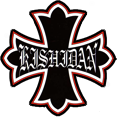Tasuki Cross
An obi, as you probably know, is that over-broad ribbon that's wrapped around the kimono several times before ending in a fancy bow at the back. But what is a 'tasuki'?
Just as Hell's Angels sport the Biker Cross like the Teutonic knights of old, this blood-red Tasuki Cross is used as tribal identification for a Japanese bosozoku biker gang (now a rare species) in their attempt to mimic the ancient Samurai.
Male members of Japanese ouendan (cheerleading squads) often wear a similar coloured sash over their formal high-school tunics.
Samurai warriors used a tasuki sash to tuck up their long sleeves, which would otherwise handicap their sword fighting or archery.
Using a bow in Japan for hunting and fighting, most likely pre-dates the Samurai era by at least one thousand years. The activity is still hugely popular as a martial art today (kyudo) and the practical tradition of using a tasuki to tuck up the kimono sleeves has been retained.
The method was also used, and still is used, by kimono wearers involved in manual work who are obliged to wear kimono; for example the tea picker shown on the left (dressed only that way today for the benefit of tourists).
It is quite common to see staff in Japanese hotels and restaurants also using a tasuki.
The tea ceremony is conducted by kimono wearers, who use a tasuki behind the scenes when making preparations, and then remove it before greeting the guests.
On the right we see a fan waiting to take part in a promotional video for the Japanese pop group Kishidan ("The Knights"), wearing a white tasuki on top of her over-sized red high school tunic. Under the tasuki is a black Cross Fleurée bearing the group's name.
(Kishidan are classic rock'n'roll: Seriously wild, ridiculously loud and energetically theatrical. See kishidan.com)
The tasuki is also worn by those taking part in traditional Japanese festivals (matsuri), such as the taiko drummers and rice planters shown on the left.
The tasuki is not always X-shaped, however.
In English, tasuki just means 'sash' and a single sash worn by a beauty queen, a campaigning politician or a marathon runner, is also called a tasuki.
A famous long distance marathon race in Japan is the ekiden, a relay race over the New Year holiday by competing university teams. Eki means 'station' and a runner from each team runs from one 'station' to the next, where he hands over the team tasuki to the next team member. If a runner retires from exhaustion or injury, or is more than twenty minutes slower than the leader at the handover station, then the whole team is retired.
It's a tough race, not so much because of the length or the hills, but because of the mental pressure.
Tears are invariably shed. The tasuki symbolises glorious victory or devastating failure, team spirit and mutual support, endurance and pride.
Returning attention to the X-shaped tasuki featured at the top of this page, for any 'symbolic meaning' we could note that the 'X' forms a St. Andrew's Cross and for around two thousand years, the meaning of the Christian cross has been thoroughly promulgated.
We could also note that the tasuki is a single belt, arranged as a lemniscate infinity symbol  , which has its own peculiar meaning (see Everlasting Cross). Rotating the lemniscate 90 degrees gives the figure '8', and eight is an auspicious number in Japanese.
, which has its own peculiar meaning (see Everlasting Cross). Rotating the lemniscate 90 degrees gives the figure '8', and eight is an auspicious number in Japanese.
That said, both the infinity symbol and the figure eight are Western symbols; neither of which has any connection with Samurai.
Yet the tasuki carries a certain tough-guy image, craved for by Japanese biker gangs.
Soldiers carry bandolier bullet belts, crossed to prevent them falling off the shoulder while running, and the crossed bandolier straps are part of ceremonial uniform, especially in Middle Eastern militaries.
The original purpose of the tasuki was as a practical way to fasten clothing; similar to the crossing red straps used to secure a nurse's old-fashioned cape. The cape's braces have no meaning, yet they enforce the image of the wearing being a healthcare worker (see Red Cross).
And let's face it; nursing is a much tougher role than riding in a noisy bike gang.
In the most famous Tokyo-Hakone-Tokyo two-day from 2 January, the runners are always male.









